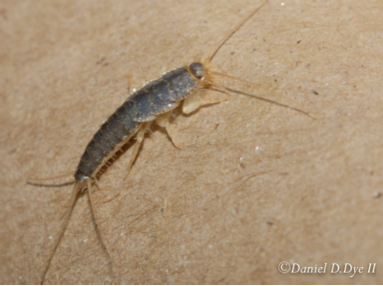 Wait…What? “The incredible, lovable Silverfish?” You’ve got to be kidding me! Well, maybe not so lovable, but definitely incredible.
Wait…What? “The incredible, lovable Silverfish?” You’ve got to be kidding me! Well, maybe not so lovable, but definitely incredible.
Did you know Silverfish are one of the most primitive insects on earth, dating back to over 400 million years ago? Now that’s incredible, don’t you think? Did you know they can live up to 6 years (providing the individual live a charmed life away from predators and the foot of a human)? Did you know they feed on almost anything in our homes? It’s true! Silverfish will feed on bookbindings, hair, clothing, carpet, glue, coffee, sugar, paper, leather, cereals and dandruff! They will even feed on their own molted exoskeleton and dead insects. So, if you think you can starve them out, think again! On top of their omnivorous appetite, Silverfish can live for 12 months or more without feeding, as long as water is available.
How do we get rid of them, you ask? We don’t! I tell you we’re doomed! Just kidding. The good news is, they’re seldom in high enough numbers to be of any concern. But, on occasion, they can get out of hand. Here’s an example of “out of hand.” You get up in the morning to brush your teeth and there it is, a Silverfish, franticly trying to climb out of the sink, but it can’t because it lacks the spongy sticky pads on its feet like roaches have. You’re ready to step in the shower and there’s another one! OMG! What next, spiders under the toilet seat? Ok, that never happens.
Infestations are often localized, so finding the source and removing it is the key to controlling these incredible creatures. Removing potential food sources, eliminating moisture, and sealing cracks, crevices and entry points around the structure is a must. If it’s a large infestation, turn your attention to outside the structure. Look for debris, woodpiles, firewood and such stacked up against the house. These are harborage areas for Silverfish. If conducive areas are found, they must be removed before any application of an approved properly labeled product. Then do a thorough treatment of any cracks, crevices and entry points around the structure.
Even after performing a thorough inspection/treatment of the interior, a Silverfish infestation could still persist. That’s when you have to step back, look at the structure and figure out what you have missed.
Here’s a true story about a persistent Silverfish infestation. A technician was having difficulty controlling Silverfish at a residential account. He explained to his supervisor what had been done, as far as control products used, application sites, etc. He just could not get them under control.
Arrangements were made to meet with the customer at their home. The home was very  well kept and clean. The customer pointed to the master bathroom as being the area with the most Silverfish activity. After inspecting the entire bathroom, including the cabinets and linen closet, only a few dead Silverfish were found. The master bedroom was then inspected without any findings.
well kept and clean. The customer pointed to the master bathroom as being the area with the most Silverfish activity. After inspecting the entire bathroom, including the cabinets and linen closet, only a few dead Silverfish were found. The master bedroom was then inspected without any findings.
The supervisor asked the technician if he had inspected the attic. The tech answered, “No.” Their next step was to inspect the attic. As they made their way over to the master bathroom area, a dead opossum was found above the bathroom! From the looks of it, it had been there a long time. The supervisor nudged the hairy hide and out poured a dozen or more Silverfish! The technician was amazed at what he had just witnessed. At that point, he realized the most important part of the service is a thorough inspection. Lesson learned!
There will be times when locating the source will be difficult, but remember we have tools such as small glue traps that can be placed and monitored. Date and number the glue traps, then place them at several locations in the area the Silverfish are seen the most. Log the number and location on paper to keep track of them. Schedule return trips weekly, or every two weeks, to check and count the number of Silverfish in the traps. The one with the highest number of catches is the winner and should be the closet to the source. Start your inspection process again from that point. Remember to place the glue traps in locations where pets and children cannot come in contact with them, on the floor and up against the wall is a proper placement…not in the middle of the floor.
Controlling Silverfish can be difficult at times. The more you know about their biology and habits, the better you will be equipped when it comes to tackling an infestation. Know your enemy…Think like a Silverfish!
Daniel D. Dye II, ACE
To listen to the companion audio podcast click here; Whistling passed the cemetery; Pests on Target talking silverfish with Daniel D.Dye II
 Daniel D. Dye II is a 40 year veteran of the pest control industry state certified in all 4 categories and an ACE. Associate certified entomologist. His passion for pest control is only rivaled by his love for nature and the opportunity to at anytime teach on any of these subjects. For more of Daniels insights and expertise please visit his Florida Backyard Spiders page and or Florida Backyard Snakes on Facebook. You can also view some of his amazing photography work on his flickr page.
Daniel D. Dye II is a 40 year veteran of the pest control industry state certified in all 4 categories and an ACE. Associate certified entomologist. His passion for pest control is only rivaled by his love for nature and the opportunity to at anytime teach on any of these subjects. For more of Daniels insights and expertise please visit his Florida Backyard Spiders page and or Florida Backyard Snakes on Facebook. You can also view some of his amazing photography work on his flickr page.




